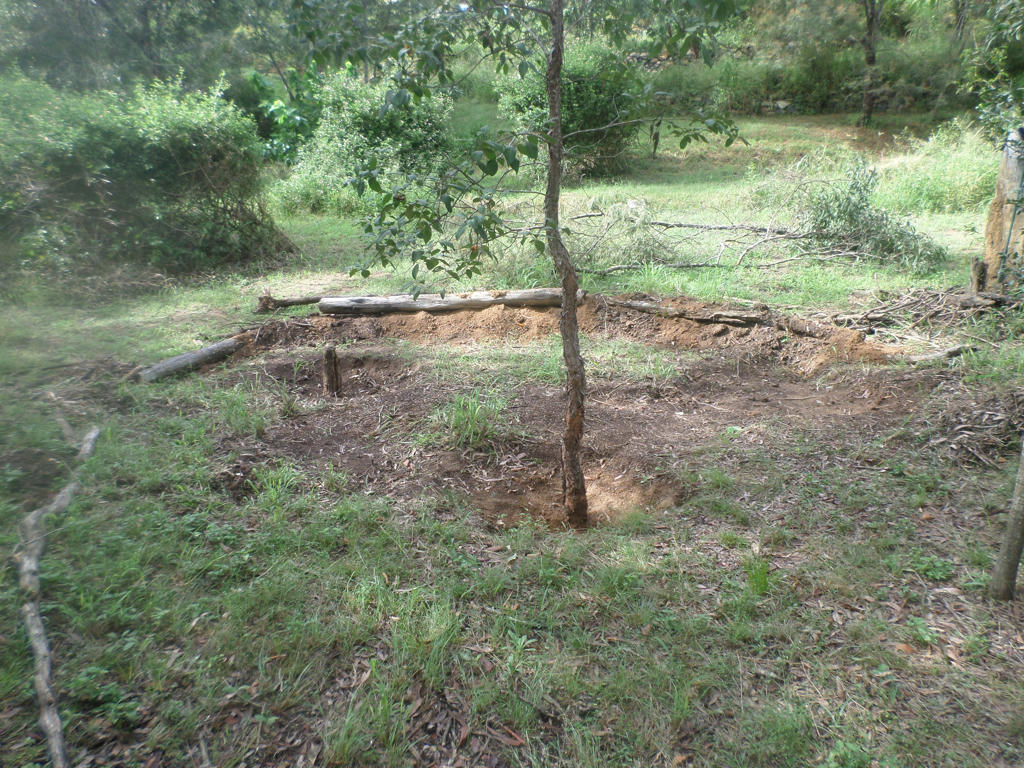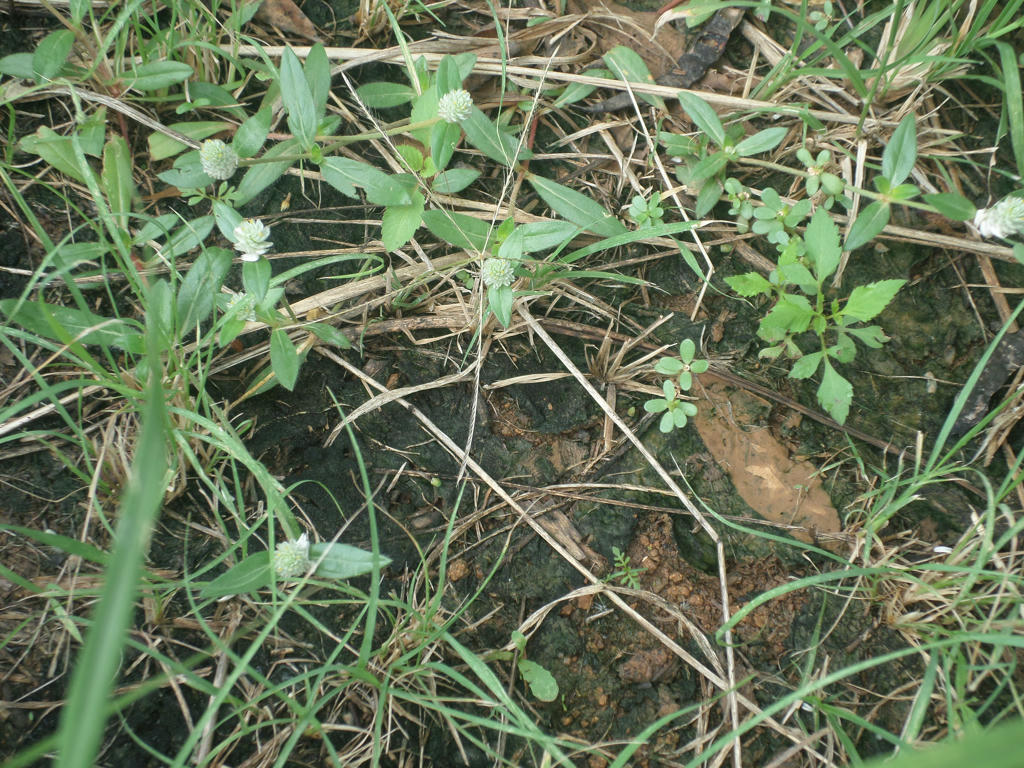Project to date - logs roughly mark pond
We aren't fans of pond liners though, not least because of the toxicity in manufacture and price, but also because we know nature has been sealing ponds very adequately, for a very long time. We just had to learn the process of how to do it. So began my research for knowledge.
First, this link has a thorough discussion on the topic of "gley" or "glei" if you're speaking Russian. Which is just the layering of biodegradable material over the surface of the pond. It creates anaerobic conditions which mats together, or seals the pond. I've seen this done naturally in our middle swale, thanks to the pigeon peas I planted above them.
Natural swale seal
They dropped their leaves and when they broke down over several seasons, eventually made a black-green slime. I had no idea at the time, this was nature sealing our swale. Yet its very distinctive, where the organic matter fell, the swale holds water. Where it doesn't, the water sinks through.
But I really like Sepp Holzer's approach to pond lining - just add pigs! The way pigs agitate the water with their hooves, they compact the soil particles regardless if the soil has clay or not. Sepp imitates this process, with the use of a excavator bucket on machinery. We won't go that route ourselves, but if you want to learn more about Sepp's techniques, visit this link.
For pretty pictures of ponds, using Sepp's techniques, see this link. You may find more information by clicking on the images.
We will probably start by adding lots of organic matter to the surface of the pond, once its dug and plan to have some deciduous trees nearby to continue the process.



You could try 'stomping' it in, to emulate the pigs. Invite some friends round for a stomping party. Gumboots provided ;-)
ReplyDeleteSomething similar was rattling around my head too. Wondering if the kids wanted to do a "Pepper Pig" impersonation of jumping up and down in muddy puddles, next downpour, lol. Great minds, think alike!
ReplyDeleteWe have a dry pond on our land. It was drained at some point but it was big enough to swim in. I am going to pay closer attention this year to find out how water behaves there. It must of been naturally sealed at some point and I wonder what's happened to that seal. Interesting post.
ReplyDeleteWere there any deciduous trees around it which came down? I noticed when we removed the pigeon peas from our top pond, the water didn't hang around as long. Although, I suspect that also has to do with higher evaporation of water, without part shade too.
ReplyDeleteYou could also try looking upstream of the pond. It may not be on your land, but see what has happened to the landscape nonetheless. Having a water source upstream can add water lower down, once it travels through the soil.
It has aspen which are diciduous. Lots of them. They sprang up in the middle of the pond as well. Not sure what changed upstream. Even when the snow melts it doesn't accumulate. I'll have to take a better look to solve the mystery:)
DeleteSorry for the late reply, but I also wanted to research the Aspen (poplar) tree before commenting. It seems to have a very quick reproduction method, by sending up shoots from its roots, and I can image they would suck any moisture from the ground rather quickly.
ReplyDeleteWe have a similar problem with the Spotted Gum. It spreads via shoots it sprouts from its spreading roots (suckers). Those areas are always incredibly dry. Any moisture in the ground gets sucked right out. Which would be great for people living near a high water table, but no so great if you don't. I wonder if the poplars are what are draining your pond from underneath?
Interesting. I was told that the Aspens are water loving and spring up iin the middle of ponds so you might be right. I asked Garry and he pointed out that to drain the spot they had to dig out a bank which is where most of the water is going out. I think the seal though was eroded over time? I'll watch the rains to see what happens this spring. Thanks for the input!
DeleteIn the absence of clay, ADD clay. That coupled with the vegetation method ought to have excellent results. Our old house had a small pond I made (we had good soil for this type of project) I'd made it with a borrowed Gannon tractor, cut ditches to manipulate water flow. It worked quite well, I even raised tilapia in it with some success.
ReplyDeleteI had to google "tilapia", because I've not heard of it before, but now I know its a fish! That's a decent pond if you can raise edible fish in it. Good work. Its fun to play around in dirt, isn't it!
ReplyDeleteWe knew clay was an option, but its such a long hike from the house, down to the gully with a wheelbarrow. It's would be a long, haul. That, and the fact I'd rather grow a solution on site. I get to value add on the property that way, as opposed to drawing expenditures to pay for inputs. We don't have a lot of money, but we do have a lot of land to grow stuff on - even if its just weeds. ;)
Thanks for sharing your success story and I hope the tilapia got to a decent size. Did you eat them?
Great read! The benefits of using RPE pond liner rolls are undeniable, especially when it comes to providing reliable, long-term solutions for pond and water reservoir construction. The reinforced structure ensures that it can handle both heavy-duty applications and extreme weather conditions, making it a top choice for various projects. I’m also impressed with the flexibility of RPE rolls, which make installation much easier and more efficient compared to traditional liner options.
ReplyDeleteIt would be interesting to know more about the different thickness options available for RPE pond liners and how to choose the right one depending on specific needs, like pond size or local climate. Also, are there any new trends in RPE liner technology that focus on enhancing UV resistance or improving environmental impact? Looking forward to more great content on this topic!
Durable and easy to install RPE pond liner manufacturers in Gujarat are perfect for creating long-lasting ponds. They're lightweight yet strong, resistant to UV damage, and environmentally friendly. Ideal for both residential and commercial use. Highly recommended for reliable performance and great value!
ReplyDelete